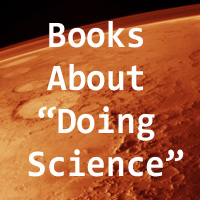 Science is noticing and questioning, seeking and creating. “Doing science” means exploring the world around us to understand what’s here and why it matters to us, seeking to comprehend what came before us so we know ourselves better, and imagining what might make the future even better—then working to get there. Each of the books in this list highlights the people and processes of science: up close, intimate, intriguing, and—most important—inspiring!
Science is noticing and questioning, seeking and creating. “Doing science” means exploring the world around us to understand what’s here and why it matters to us, seeking to comprehend what came before us so we know ourselves better, and imagining what might make the future even better—then working to get there. Each of the books in this list highlights the people and processes of science: up close, intimate, intriguing, and—most important—inspiring!
What’s in our world, and why does it matter to us?
Rusch, Elizabeth. (2013). Eruption: Volcanoes and the Science of Saving Lives. Illus. by Tom Uhlman.Houghton Mifflin Harcourt. (geology; grades 4 and up)
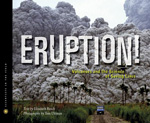 Nevada del Ruiz in what is now Colombia erupted violently in 1595, killing 630 members of a native tribe living nearby. It waited 250 years to erupt again, this time burying an entire village in volcanic mud. In 1985, 139 years after the last eruption, the sleeping volcano awoke once again, killing 23,000 people in the town of Amero. A year after this tragedy, a small group of volcanologists determined to prevent such tragedies banded together to form the Volcano Disaster Assistance Program, the “first and only international volcano crisis team.” Their mission? To bring their expertise and the latest technology to threatened communities in an attempt to predict eruptions and save lives. The VDAP team races around the globe to respond to immediate threat, but with more than 1,500 active volcanoes, they can only do so much. That’s where Volcano Training Camp comes in. Volcanologist from around the world come to train at the Cascades Volcano Observatory in Washington State, where scientists pass on what they learned from the Mt. Saint Helens eruption in 1980. Visiting scientists take what they learn at camp back to protect their own communities. Striking photos and well-placed, informative charts and maps illuminate the scope and power of volcanic activity. Geology content is shared in a context that makes it relevant and will generate interest in further inquiry. Like the other books in this collection, Eruption makes it clear why science matters to us.
Nevada del Ruiz in what is now Colombia erupted violently in 1595, killing 630 members of a native tribe living nearby. It waited 250 years to erupt again, this time burying an entire village in volcanic mud. In 1985, 139 years after the last eruption, the sleeping volcano awoke once again, killing 23,000 people in the town of Amero. A year after this tragedy, a small group of volcanologists determined to prevent such tragedies banded together to form the Volcano Disaster Assistance Program, the “first and only international volcano crisis team.” Their mission? To bring their expertise and the latest technology to threatened communities in an attempt to predict eruptions and save lives. The VDAP team races around the globe to respond to immediate threat, but with more than 1,500 active volcanoes, they can only do so much. That’s where Volcano Training Camp comes in. Volcanologist from around the world come to train at the Cascades Volcano Observatory in Washington State, where scientists pass on what they learned from the Mt. Saint Helens eruption in 1980. Visiting scientists take what they learn at camp back to protect their own communities. Striking photos and well-placed, informative charts and maps illuminate the scope and power of volcanic activity. Geology content is shared in a context that makes it relevant and will generate interest in further inquiry. Like the other books in this collection, Eruption makes it clear why science matters to us.
- Suzii Christian Parsons, Oklahoma State University
Heos, Bridget. (2013). Stronger than Steel: Spider silk DNA and the Quest for Better Bulletproof Vests, Sutures, and Parachute Rope. Illus. by Andy Comins. Houghton Mifflin Harcourt. (chemistry and biology; grades 5 and up)
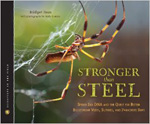 Anyone who has walked through a web is aware of the tenacity of spider silk. But did you know that it is one of the strongest materials on Earth? The scientific team featured in Stronger Than Steel is working to find ways to produce spider silk in amounts substantial enough for creating super-strong products for human use. Possible uses range from medical (super-strong and delicate sutures, artificial ligaments and tendons) to military (parachute rope, wires to stop planes on aircraft carriers, even body armor). The most likely candidates for producing the silk? Transgenic goats (a spider gene has been introduced to their genetic make-up) that produce spider silk protein in their milk, alfalfa crops that have also been “infected” with spider silk genes, and silkworms that have had their natural production boosted the same way. Heos takes on heavy subject matter in this book, explaining DNA and the processes of genetic alteration with clear explanations and comparisons to common experiences. A strong focus on the day-to-day lives of the scientists working on this project makes the topic feel even more accessible. Stronger Than Steel takes a generally positive stance to genetic engineering, but Heos does address controversies and concerns, providing readers of all ages plenty to ponder.
Anyone who has walked through a web is aware of the tenacity of spider silk. But did you know that it is one of the strongest materials on Earth? The scientific team featured in Stronger Than Steel is working to find ways to produce spider silk in amounts substantial enough for creating super-strong products for human use. Possible uses range from medical (super-strong and delicate sutures, artificial ligaments and tendons) to military (parachute rope, wires to stop planes on aircraft carriers, even body armor). The most likely candidates for producing the silk? Transgenic goats (a spider gene has been introduced to their genetic make-up) that produce spider silk protein in their milk, alfalfa crops that have also been “infected” with spider silk genes, and silkworms that have had their natural production boosted the same way. Heos takes on heavy subject matter in this book, explaining DNA and the processes of genetic alteration with clear explanations and comparisons to common experiences. A strong focus on the day-to-day lives of the scientists working on this project makes the topic feel even more accessible. Stronger Than Steel takes a generally positive stance to genetic engineering, but Heos does address controversies and concerns, providing readers of all ages plenty to ponder.
- Suzii Christian Parsons, Oklahoma State University
What came before us, and what can that tell us about ourselves?
Deem, James. (2012). Faces from the Past: The Forgotten People of North America. Houghton Mifflin Books for Children.(chemistry and biology; grades 7 and up)
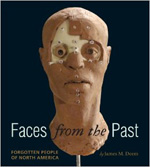 In Faces from the Past, Deem details how archeologists use the combined powers of chemistry, biology, history, and art to learn about those who lived before us. The book includes nine case studies of forgotten people rediscovered, beginning with “the man from Spirit Cave,” whose remains were first discovered in 1940 and 50 years later were determined to be more than 10,000 years old. Others whose lives were brought to light long after their deaths include ancestors of the Monocan Indians of Virginia, a French sailor from LaSalle’s failed expedition to the New World, a Mexican solider who died at the Battle of San Jacinto, and a Buffalo Soldier who died of cholera while serving at Fort Craig in New Mexico. Discoveries near Albany, New York, echo a theme of “the forgotten poor”—a servant woman whose remains were found during excavation for street improvement, slaves whose burial places were undocumented, and residents of an almshouse—infants to elderly—buried in a cemetery discovered again through construction. Each case study can stand alone for individual reading, but together they highlight the delicate dance between scientific exploration and social concerns. The text is clear, direct, and engaging, replete with photographs of archeological work and supporting artifacts, plus sidebars that often provide more insight into the human stories.
In Faces from the Past, Deem details how archeologists use the combined powers of chemistry, biology, history, and art to learn about those who lived before us. The book includes nine case studies of forgotten people rediscovered, beginning with “the man from Spirit Cave,” whose remains were first discovered in 1940 and 50 years later were determined to be more than 10,000 years old. Others whose lives were brought to light long after their deaths include ancestors of the Monocan Indians of Virginia, a French sailor from LaSalle’s failed expedition to the New World, a Mexican solider who died at the Battle of San Jacinto, and a Buffalo Soldier who died of cholera while serving at Fort Craig in New Mexico. Discoveries near Albany, New York, echo a theme of “the forgotten poor”—a servant woman whose remains were found during excavation for street improvement, slaves whose burial places were undocumented, and residents of an almshouse—infants to elderly—buried in a cemetery discovered again through construction. Each case study can stand alone for individual reading, but together they highlight the delicate dance between scientific exploration and social concerns. The text is clear, direct, and engaging, replete with photographs of archeological work and supporting artifacts, plus sidebars that often provide more insight into the human stories.
- Suzii Christian Parsons, Oklahoma State University
What’s out there?
Rusch, Elizabeth. (2012). The Mighty Mars Rovers: The Incredible Adventures of Spirit and Opportunity. Houghton Mifflin Books for Children. (astronomy, geology, physics; grades 4 and up).
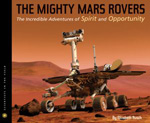 Rusch details the story of Mars Exploration Rovers Spirit and Opportunity, from inception to design and construction, then through launch, landing, and, incredibly, more than six years of Red Planet exploration. Told largely through the eyes and words of Steve Spires, whose childhood wonderings eventually sparked and fueled this history-making foray onto the surface of Mars, the book reads with an intimacy that emphasizes the passion, tension, and sheer drama of space exploration. The dual roles of inspiration and perspiration take center stage here as readers walk with the rover developers through years of trial and error, failure and ultimate success. Breathtaking photos of the planet surface are paired with pictures of the team at work. Captions clearly explain photos or highlight quotes that give voice to the scientific process. Even if you know the outcome before you begin, this book provides a “nail biter” experience that may actually elicit groans and cheers; it did for me and my young “test readers.”
Rusch details the story of Mars Exploration Rovers Spirit and Opportunity, from inception to design and construction, then through launch, landing, and, incredibly, more than six years of Red Planet exploration. Told largely through the eyes and words of Steve Spires, whose childhood wonderings eventually sparked and fueled this history-making foray onto the surface of Mars, the book reads with an intimacy that emphasizes the passion, tension, and sheer drama of space exploration. The dual roles of inspiration and perspiration take center stage here as readers walk with the rover developers through years of trial and error, failure and ultimate success. Breathtaking photos of the planet surface are paired with pictures of the team at work. Captions clearly explain photos or highlight quotes that give voice to the scientific process. Even if you know the outcome before you begin, this book provides a “nail biter” experience that may actually elicit groans and cheers; it did for me and my young “test readers.”
- Suzii Christian Parsons, Oklahoma State University
How can I be a scientist?
Burns, Loree Griffin. (2012). Citizen Scientists: Be a Part of Scientific Discovery from Your Own Backyard. Photos by Ellen Harasimonwicz.Henry Holt and Company/Square Fish. (biology, environmental science; grades 2 and up)
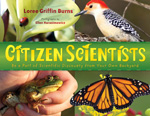 Burns begins with a definition: “A citizen is any resident of our world….Science is a systematic study of our world.…Citizen science, then, is the study of our world by the people who live in it.” That would be every reader, of course, and this book is really an invitation to join the community of scientists—complete with directions for how to get to the party. Burns devotes a chapter each to four ongoing, large-scale scientific studies that rely on everyday citizens to collect and report data. Readers learn how to catch and tag monarch butterflies in the fall to help scientists understand migration patterns and the effects of changing environmental conditions. They are enticed to don hats, coats, and gloves to participate in the Christmas Bird Count, the oldest bird monitoring project in the U.S., which has produced and continues to produce mountains of data to help us understand our constantly changing world. After that, they can study frog calls from a CD in order to participate in spring frogging, listening for different calls and reporting which frogs (indicator species that tell us a lot about the health of our planet) are still hopping healthily in their area. In the summer it’s time for ladybugging—sweeping fields with nets to capture and identify ladybug species and reporting findings to the Lost Ladybug Project, a study that seeks to determine which species are thriving where. This is a “can do” book. Engaging descriptions of the projects are paired with accessible resources to effectively connect young readers with the science in their backyards and the scientists within themselves.
Burns begins with a definition: “A citizen is any resident of our world….Science is a systematic study of our world.…Citizen science, then, is the study of our world by the people who live in it.” That would be every reader, of course, and this book is really an invitation to join the community of scientists—complete with directions for how to get to the party. Burns devotes a chapter each to four ongoing, large-scale scientific studies that rely on everyday citizens to collect and report data. Readers learn how to catch and tag monarch butterflies in the fall to help scientists understand migration patterns and the effects of changing environmental conditions. They are enticed to don hats, coats, and gloves to participate in the Christmas Bird Count, the oldest bird monitoring project in the U.S., which has produced and continues to produce mountains of data to help us understand our constantly changing world. After that, they can study frog calls from a CD in order to participate in spring frogging, listening for different calls and reporting which frogs (indicator species that tell us a lot about the health of our planet) are still hopping healthily in their area. In the summer it’s time for ladybugging—sweeping fields with nets to capture and identify ladybug species and reporting findings to the Lost Ladybug Project, a study that seeks to determine which species are thriving where. This is a “can do” book. Engaging descriptions of the projects are paired with accessible resources to effectively connect young readers with the science in their backyards and the scientists within themselves.
- Suzii Christian Parsons, Oklahoma State University
These reviews are submitted by members of the International Reading Association's Children's Literature and Reading Special Interest Group (CL/R SIG) and are published weekly on Reading Today Online. The International Reading Association partners with the National Council of Teachers of English and Verizon Thinkfinity to produce ReadWriteThink.org, a website devoted to providing literacy instruction and interactive resources for grades K–12.